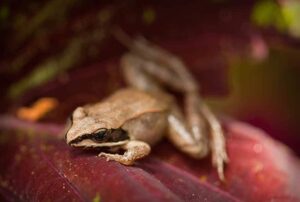More than a few people have quietly approached a spring pond with the hopeful expectation of identifying a duck making the gentle “quacking” sound they were hearing, only to discover the staccato call is that of the male wood frog! Few species of these temperature-sensitive, cold-blooded creatures are able to tolerate Alaska’s climate but the wood frog (Rana sylvatica) is the one amphibian which lives north of the Arctic Circle.
It is widely distributed in Alaska and can be found from north of the Brooks Range to Southeast, in muskeg, tundra and forest. During the spring breeding season, the male’s loud voice is commonly heard around most ponds and lakes. Only the males are vocal and are typically more active in the daylight hours, taking advantage of the sun’s heat. Wood frogs have smooth, light brown to gray skin with a variety of patterns on top and a cream-colored belly. Most have a dark mask ending behind the ears, a white stripe along the upper jaw and prominent ridges along its back.
They are only about 3 inches long and have well-developed ears. Proportionally, they have squat bodies, large heads, large eyes, long hind legs and long, sticky tounges to catch insects with. Luckily, one of their favorite foods is mosquitoes! In winter, wood frogs burrow into mud or under a blanket of dead vegetation and sleep through the season. Winter mortality is high but still the frogs are abundant.
The wood frog is an amphibian, one of the five main groups of vertebrates which are animals that possess backbones and have complex brains and highly developed senses. Amphibians played an instrumental role in the evolution of animals in that they were the first limbed land-dwellers. They evolved from fishes 300-400 million years ago and like fishes, are cold-blooded and their activity levels are greatly influenced by the environment. For more than 100 million years amphibians were the dominant land vertebrates.

The first fish-like amphibians to leave the water could do so because they could breath air with a set of lungs instead of gills and bore leg like appendages which provided them a whole new environment to exploit on land. This allowed much less competition than the intense “survival of the fittest” in the waters. Still, they are dependent on aquatic environments for survival and reproduction. The females lay eggs in or near water and the young hatch as tadpoles, (which look and act more like fish than land- dwellers, breathing through gills for example).
After a short developmental period they develop lungs and legs and metamorphose into what we know as frogs. In almost any body of fresh water in the spring you can see the tadpoles swimming in the shallows. They are an important food source for some birds and other small animals. Only 3 other types of amphibians live in Alaska (out of thirty-three hundred species worldwide) so, you can consider a “sighting” of one of these small animals as quite unique. Many places have their spring peepers (which are actually tree frogs). Here in Alaska, the wood frog male’s spring mating song is one more wonderful tribute to the tenacity of northern creatures which are hardy enough to make it through one more winter.




